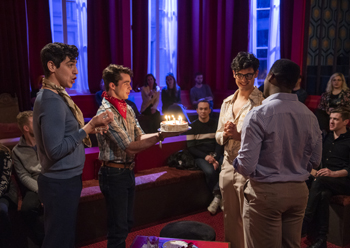
Theatergoers already familiar with Windy City Playhouse's "immersive theater" techniques were unperturbed when their access into its production of Mart Crowley's The Boys In The Band led them through a faux foyer, then up a trompe l'oeil elevator and down an anonymous hallway to arrive at a likewise nondescript door. Oh, but nobody, not even playgoers retaining first-hand memories of the 1968 Broadway premiere or subsequent William Friedkin movie, could have anticipated what would greet them on the other side.
What we see upon entering the apartment where Micheal is preparing to host a birthday party is not the muted chrome-and-naugahyde furnishings of the iconic original, but an interior landscape modeled on an Arabian Nights fantasy, its palette shimmering with saturated hues of cinnabar, tangerine and fuchsia to dominate the sunken "conversation pit" anchoring the center of an arena-sized room, ringed by quasi-Mark Rothko abstract canvases, a kitchen more elaborate than any Manhattan resident ever needed and, on its very perimeter, banquettes where uninvited spectators (aka audience) will be seated.
Upon closer scrutiny, though, we glimpse, tucked away in a corner amid this summer-of-love dazzle, a loft bedroom and bathroom—the latter representing the sole area not exposed to the general purview—chromatically recessed by walls papered in a slate-blue-and-mustard-yellow key pattern. We also notice strategically-located shadows generated by the scattered accent lamps and the view from the single window of the neighboring hi-rise's blank wall. Later, when Micheal admits to habitually spending beyond his means, we are not surprised to hear that this Emporium of Excess conceals secrets.
To be sure, gay historians could argue that shadows and secrets constituted a ubiquitous component in virtually every home occupied by "homosexuals" in 1968. Consensual sex between adults of the same sex was still illegal in the United States—indeed, merely dancing together in ballroom formation could lead to arrest, incarceration and public shaming. The guests at this reunion have no way of knowing that only a year later, real-life men and women would rise up in rebellion to change America's social order forever.
 "As a designer, it's my job to tell a story," declares scenic artist William Boles, faced with conveying the despair of these "dark ages" to audiences blessed with hindsight in 2020, "and I do that—but with certain liberties."
"As a designer, it's my job to tell a story," declares scenic artist William Boles, faced with conveying the despair of these "dark ages" to audiences blessed with hindsight in 2020, "and I do that—but with certain liberties."
What we know about Michael from the play's text is that he is a writer who can barely pay his rent and has stopped drinking because he can no longer tolerate the morning-after remorse. Boles chooses to have Michael's living quarters recount a backstory of selling a script that brought him a big check enabling him to renovate his pre-WWII apartment, turning it into an up-to-the-minute playpen that is "an amalgam of everything he wishes he was."
Writing being a solitary occupation, most authors' habitats tend to resemble workplaces, its surfaces crowded with books, manuscripts and sundry wordcrafting tools. Why did Michael choose to squander his latest windfall on such a social environment?
While researching the subtextual possibilities of Michael's decorating choices, Boles' attention was captured by the interior design of David Hicks, whose startling colors and exaggerated proportions gained popularity in fashionable New York City during the early 1960s. "Since the script indicates that Michael is consumed with how he is perceived by others," explains Boles, "he would likely be attracted by the allure of the bold statement—but it also contains lots of fragile elements, like mirrors and glass.
"The sense of celebration arising from this wildly colorful environment" is important, insists Boles, because, as the play progresses, "we gradually see it crack, and shatter." At the end of the play, Michael surveys the wreckage of the fašade he has tried so carefully to construct, and what does he do but contemplate burning the whole room before setting out to once again confess, atone and perhaps start over, this time on a more auspicious path to a more promising future.
The Boys In the Band runs at Windy City Playhouse through May 17.
Mary Shen Barnidge
Contributing Writer

 Follow Us On Twitter
Follow Us On Twitter